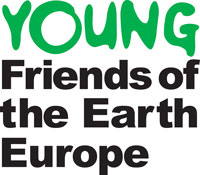Brussels, 22 June 2006 – Friends of the Earth Europe have demanded urgent climate action from European governments, after new data reveals that overall EU emissions continue to rise. The latest figures, released by the European Commission today, show that EU emissions actually rose by 0.4% in 2004 relative to the previous year[1].
In 2004, the combined EU-15 [2] emissions were only 0.9% below 1990 levels, meaning that the EU-15 is shamefully off-course to meet its international Kyoto Protocol obligations to cut greenhouse pollution by 8% by 2012.
Jan Kowalzig, climate campaigner at Friends of the Earth, said:
“As these new figures embarrassingly show, our European leaders still haven’t woken up to the climate crisis. Europe’s governments make grand statements about their commitment to reduce greenhouse gas pollution, yet economy and industry Ministers continue to block or water down policy measures to switch to renewable energies, reduce energy waste or introduce fuel consumption standards for cars.”
According to the new data, Spain, Luxembourg, Austria, Portugal, Italy, Finland, Denmark and Ireland are the worst performers, drifting furthest from their Kyoto emission targets.[3] Across Europe, overall energy demand is on the rise, while renewable energy share to meet this demand is stagnating at around 6%. Also, the energy efficiency of the European economy shows only minor improvements over the past years.
Road and air transport are among the biggest culprits, with emissions from these sectors contributing most to the recent emissions increase. This is a result of a staggering growth in demand for cars and flights and because, for example, governments are failing to introduce binding fuel consumption standards for cars.
“Governments do not have the option to give global warming a backseat in favour of short term interests. The benefits of avoiding catastrophic climate change will clearly outweigh the costs of abatement policies.[4] And switching to renewable energies will generate hundreds of thousands of new jobs throughout Europe and reduce the dependence on foreign energy imports at times of soaring oil & gas prices,[5] “ Mr Kowalzig added.
Friends of the Earth Europe identifies 6 key areas for urgent action:[6]
- EMISSIONS TRADING: In the 2008-2012 phase of the European Emissions Trading, the total amount of pollution permits given out to industry must be drastically reduced. Only if there is a shortage in permits will the trading lead to investments in cleaner technologies and reducing emissions.
- EFFICIENCY: Europe needs a binding target to cut energy consumption by 20% by 2020, through increasing efficiency, thereby also reducing energy costs for households and industry and curbing greenhouse gas pollution.
- RENEWABLES: By 2020, Europe should meet 25% of its primary energy demand from renewable sources, making Europe less dependent on imported fossil fuels and also reducing the hidden costs of conventional power generation.
- TRANSPORT: Europe must reverse the unsustainable growth trends in the transport sector that uses up 70-80% of all oil imports into the EU and accounts for a third of Europe’s total energy use.
- NUCLEAR POWER: Europe must phase out expensive and dangerous nuclear energy that can not survive in a liberalised energy market, especially if the high costs of decommissioning and the long-term nuclear waste storage for thousands of years are taken into account.
- SUBSIDIES: Europe must remove perverse subsidies and other market distortions that keep dirty energy artificially cheap in comparison to its renewable competitors.
***
Notes:
[1] The new figures are the greenhouse gas emission figures from 2004, as the data always comes with a delay of two years. They show that while for example in 2003, emissions in the EU-15 were 1.2% below “base year”, which for most countries and gases is 1990, in 2004 they were only 0.9% below 1990 levels. In order to meet the requirements of the Kyoto Protocol, EU-15 emissions must be on average at least 8% below 1990 levels between 2008 and 2012. A “linear target path” drawn from 1990 to 2010 in order to meet the Kyoto target shows that in 2004 emissions should have been 5.6% lower than they were in 1990, instead of the meagre minus 0.9%. The official data is available at http://www.eea.eu.int
[2] EU 15 = 15 Member States in the EU before the enlargement in 2004:
Austria, Belgium, Denmark, Finland, France, Germany, Greece, Ireland, Italy, Luxembourg, Netherlands, Portugal, Spain, Sweden, United Kingdom
Austria : -13.0% (2004 levels: +15.7%)
Belgium: -7.5% (2004 levels: +0.7%)
Czech Republic: -8.0% (2004 levels: -25.1%)
Denmark: -21.0% (2004 levels: -1.8%)
Estonia: -8.0% (2004 levels: -50.0%)
Finland: +0.0% (2004 levels: +14.5%)
France : +0.0% (2004 levels: -0.8%)
Germany: -21.0% (2004 levels: -17.5%)
Greece: +25.0% (2004 levels: +23.9%)
Hungary: -6.0% (2004 levels: -32.0%)
Ireland: +13.0% (2004 levels: +22.7%)
Italy: -6.5% (2004 levels: +12.3%)
Latvia: -8.0% (2004 levels: -58.5%)
Lithuania: -8.0% (2004 levels: -60.1%)
Luxembourg: -28.0% (2004 levels: +0.3%)
Netherlands: -6.0% (2004 levels: +1.6%)
Poland : -6.0% (2004 levels: -31.6%)
Portugal: +27.0% (2004 levels: +41.0%)
Slovakia: -8.0% (2004 levels: -30.3%)
Slovenia: -8.0% (2004 levels: -0.8%)
Spain: +15.0% (2004 levels: +47.9%)
Sweden: +4.0% (2004 levels: -3.6%)
United Kingdom: -12.5% (2004 levels: -14.1%)
http://ec.europa.eu/energy/res/biomass_action_plan/green_electricity_en.htm [6] See also Friends of the Earth’s background briefing on the New Energy Policy for Europe at:
http://www.foeeurope.org/climate/download/background_NewEnergyPolicy_Council.pdf







